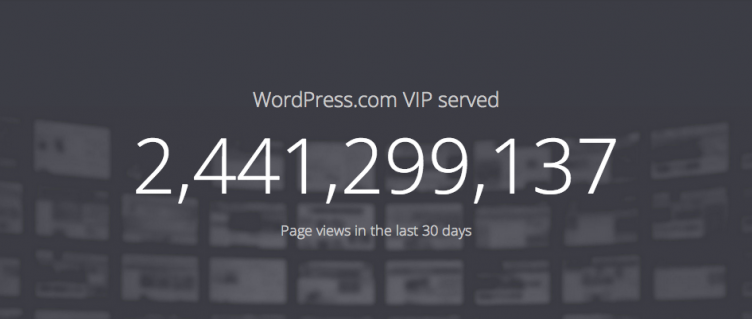 WordPress.com VIP has a fancy new stats page.
WordPress.com VIP has a fancy new stats page.
Of course I immediately wanted to know how it stacks up to WordPress.com stats as a whole. Here’s the math:
- WordPress.com VIP: 2,441,299,137 pageviews in the last 30 days
- All WordPress.com: 14,512,740,573* pageviews in the last 30 days
My incredible math skills tell me that means 16.82% of WordPress.com’s “network” pageviews are on VIP client sites.
I’ve always wanted to know that.
Now for the big asterisk! The network, according to the generic WordPress.com stats page, includes Jetpack enabled sites. So, that adds (I assume) up to a couple million websites and those pageviews.
In other words, 16.82% is diluted with however many pageviews of the 14.5 billion are served on self-hosted Jetpack-enabled websites. So the real percentage of pure .com pageviews that are for VIP clients is even higher.
The VIP stats page also has some other interesting notes:
- 99.9722% uptime in the last 30 days. That’s good, and means it’s been down for about 20 minutes in that timeframe.
- 297ms “response time”. Keep in mind, that’s not page load times, which vary from site to site considerably.
- 21,193 “publishers”, which I’ve clarified with VIP means the number of registered users that exist on those VIP sites.
Now you have some fun facts for your dinner parties.
The 0.01%
WordPress.com has millions of users. I can’t find the stat, unfortunately, but I think it’s along the lines of 30+ million registered users. If we assume there are 30 million, that would mean that those 21,193 publishers on WordPress.com VIP are getting nearly 17% of all pageviews, even though they make up less than 0.01% of users. I think they call those power users.
VIP as a revenue source
WordPress.com VIP is an interesting beast. It’s not the primary revenue generator at Automattic. It has grown in revenue over the years, but over time it’s become a smaller part of their overall revenue. It’s my understanding that VIP is about a sixth of the revenue stream for Automattic, whereas at one point it was around a quarter.
This means that other sources of revenue have outpaced VIP revenue, which makes sense. WordPress.com VIP simply can’t scale as a service business the same way that WordPress.com products can. But there is no mistaking the importance of the platform and publishers that make up the WordPress.com VIP network, and these numbers help prove it.
